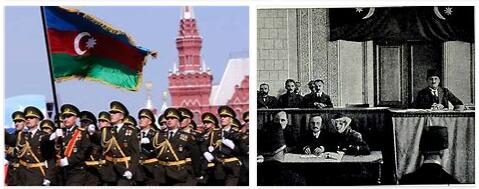The 18 of October of 1991 the Constitutional Act on State Independence of the Republic of Azerbaijan, of which the foundations of the state, political and economic system of independent Azerbaijan was established was enacted. From that moment on, the country was once again an independent subject of international law after a 71-year hiatus.
However, between the end of 1991 and the beginning of 1992 the Armenian armed formations carried out military operations in Nagorno Karabakh with the most modern weapons until they occupied the city of Khodyali in February 1992, where they brutally tortured and killed more than 600 civilians. occurring the so-called Jodyalí Genocide or Khodyalí Massacre, and in May 1992 they occupied the city of Shushá and its district. As a result of these actions, the entire Azerbaijani population was expelled from Nagorno Karabakh and the occupation of the region was completed. Following the occupation of the Lachín district in May 1992, the Nagorno Karabakh Territory was joined with Armenia.
Subsequently, the military actions crossed the limits of the region and spread through the territory of the Republic, beyond the administrative borders of the Nagorno Karabakh Region, reaching the border between Armenia and Azerbaijan. Armenia occupied another 7 districts (Kalbeyér, Lachín, Agdám, Fizuli, Gubadlí, Zanguilán, Jabraíl) of Azerbaijan.
Thus, as a result of the Armenian aggression against the Republic of Azerbaijan, more than 17,000 km² were occupied, which represents approximately 20% of the national territory, including Nagorno Karabakh and 7 other adjacent districts. For this reason, more than 50,000 people were injured or disabled and more than 18,000 died, while 877 human settlements, 100,000 residential buildings, more than 1,000 production facilities, more than 600 schools and educational establishments were looted and destroyed., 250 medical institutions and most of the architectural monuments of the occupied area.
Due to the aggression and ethnic cleansing against Azerbaijanis both in the territory of Armenia itself and in the occupied Azerbaijani lands, there are approximately more than 1 million refugees and displaced persons in Azerbaijan.
In February 1992, the mediation process for the solution of the Nagorno Karabakh Conflict (territory officially recognized by the United Nations Organization as part of Azerbaijan, illegally occupied by Armenia) began within the framework of the Conference on Security and Cooperation in Europe (CSCE). At the session of the CSCE Council of Ministers held in Helsinki on March 24, 1992, it was decided to hold in Minsk a CSCE conference on Nagorno Karabakh, as a permanent negotiating forum to find a peaceful solution to the conflict based on the principles, obligations and provisions of the CSCE.
The United Nations Security Council in its resolutions 822 (1993) of the 30 of April of 1993 adopted at its 3205 to session, 853 (1993) , of 29 of July of 1993 adopted at its 3259 to session, 874 (1993) , of 14 of October of 1993 adopted at its 3292 a session and 884 (1993) , from December to November of 1993 adopted at its 3313 tosession, condemned the occupation of the territory of the Republic of Azerbaijan, reaffirmed respect for the sovereignty, territorial integrity and inviolability of the borders of the Republic of Azerbaijan and the inadmissibility of the use of force for the acquisition of territories, and also demanded the immediate cessation of hostilities and hostile acts, as well as the immediate, complete and unconditional withdrawal of all Armenian occupation forces from the occupied districts of the Republic of Azerbaijan.
Likewise, the UN General Assembly, guided by the purposes, principles and provisions of the Charter of the United Nations and recalling the resolutions of the Security Council previously listed, as well as its resolutions 48/114 (1993) , of 20 December 1993, entitled International emergency assistance to refugees and displaced persons in Azerbaijan, and 60/285 (2006) , dated September 7, 2006, entitled The situation in the occupied territories of Azerbaijan, also recalling the report of the fact-finding mission of the Minsk Group of the Organization for Security and Cooperation in Europe to the occupied territories of Azerbaijan near Nagorno Karabakh and the letter of the co-chairs of the Minsk Group to the Permanent Council of the Organization for Security and Cooperation in Europe on the fact-finding mission, adopted at its sixty-second session held on March 14, 2008 resolution 62/243 (2008) entitled The situation in the occupied territories of Azerbaijan, in which it is reaffirmed that no State will recognize as lawful the situation created by the occupation of the territories of the Republic of Azerbaijan or provide aid or assistance to maintain that situation; respect and support for the sovereignty and territorial integrity of the Republic of Azerbaijan within its internationally recognized borders, the inalienable right of the population expelled from the occupied territories of the Republic of Azerbaijan to return to their homes and emphasizes the need to create adequate conditions for their return, including the full rehabilitation of the territories affected by the conflict; demanding the immediate, total and unconditional withdrawal of all Armenian forces from all the occupied territories of the Republic of Azerbaijan.
Despite internal problems and external pressures, after the election of President Heydar Aliyev in 1993, unemployment in the country was reduced, the fundamental institutions of the independent state were established, stability, peace, significant foreign investment and investment were achieved. The economy was improved, in particular with the exploitation of the oil fields. This strategy was continued by his successor, President Ilham Aliyev.
As a country located in Asia according to COMPUTERANNALS, today Azerbaijan is a democratic country with rapid global economic growth as well as a stable political system.
